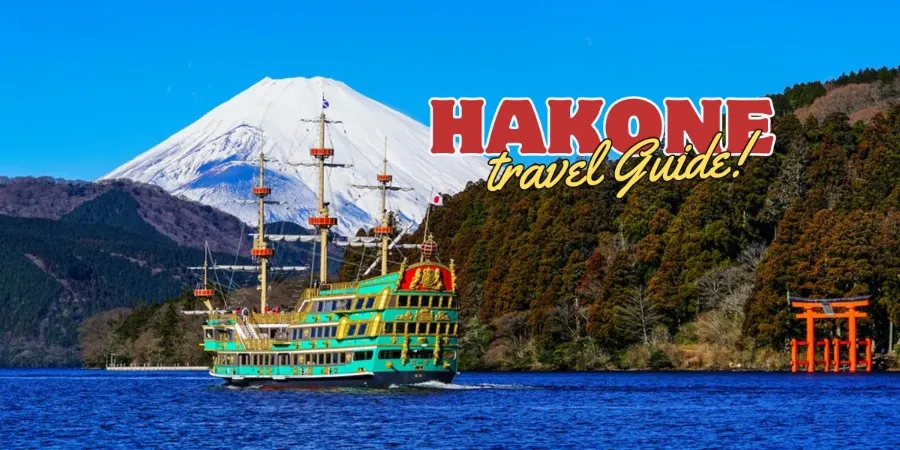Discover Hakone: A Complete Travel Guide
Have you ever heard of Hakone? This hidden gem in Japan offers the perfect blend of natural beauty and cultural heritage. Let's find out with Goemon why this place is a must-visit destination!

Hakone, located in Kanagawa Prefecture, is one of Japan’s most popular destinations, famous for its hot springs, stunning views of Mount Fuji, and rich cultural heritage. Just a short trip from Tokyo, Hakone offers a perfect escape from the bustling city, combining natural beauty with historical significance. Whether you're looking to relax in an Onsen, explore traditional shrines, or take in breathtaking scenery, Hakone has something for everyone.
Source: Trip to Japan
1. How to Get There
Getting to Hakone from Tokyo is convenient and straightforward. Here are the most common ways to travel:
- By Train: The Odakyu Romancecar is a popular choice, providing a direct connection from Shinjuku Station to Hakone-Yumoto Station in about 85 minutes. If you have a Japan Rail Pass, you can take the JR Tokaido Shinkansen to Odawara Station and transfer to a local train for Hakone-Yumoto.
- By Bus: Highway buses run from Tokyo to Hakone and take about 2 hours. This is a budget-friendly option and offers beautiful views along the way.
- By Car: Renting a car is also an option, especially if you want to explore Hakone at your own pace. The drive from Tokyo to Hakone takes around 90 minutes, depending on traffic.
2. Best Time to Visit Hakone
Hakone is a year-round destination, but the experience changes with the seasons:
- Spring (March to May): Cherry blossoms bloom, making it one of the most picturesque times to visit. The cool weather is perfect for hiking.
- Summer (June to August): The lush greenery and mild temperatures make summer an excellent time for outdoor activities. Though it’s the rainy season, there are still many clear days to enjoy.
- Autumn (September to November): The autumn foliage is breathtaking, with vibrant reds, oranges, and yellows covering the landscape. This is perhaps the most popular time to visit Hakone.
- Winter (December to February): Winter offers clear views of Mount Fuji and a cozy atmosphere in the hot springs. Snowfall can enhance the scenic beauty, particularly around Lake Ashi.
The beauty of Hakone in all four seasons
3. Top Attractions in Hakone
Lake Ashi
- Address: Monohakone, Hakone-machi, Ashigarashimo-gun, Kanagawa
Source: Tourist Japan
This picturesque lake, with views of Mount Fuji on clear days, is one of Hakone’s iconic sights. Visitors can enjoy a cruise on a pirate ship or explore the scenic walking trails around the lake.
Hakone Shrine
- Address: 80-1 Motohakone, Hakone-machi, Ashigarashimo-gun, Kanagawa
Source: クラブシーリズム
Located on the shores of Lake Ashi, Hakone Shrine is known for its red torii gate that stands in the water. The shrine is surrounded by dense forest, offering a peaceful and spiritual experience.
Owakudani Valley
- Address: Sengokuhara, Hakone, Ashigarashimo, Kanagawa, 250-0631
Source: Traveloka
A volcanic valley with active sulfur vents and hot springs, Owakudani offers a unique and slightly surreal landscape. Don’t miss the chance to try the famous black eggs (Kuro-tamago) boiled in the hot springs, which are said to add seven years to your life!
Hakone Open-Air Museum
- Address: 1121 Ninotaira, Hakone-machi, Ashigarashimo-gun, Kanagawa
- Opening hours: every day of the week, from 09:00 to 17:00.
Source: 彫刻の森美術館
This outdoor art museum features modern sculptures set against a backdrop of mountains and natural beauty. It’s a must-visit for art enthusiasts.
Hakone Onsen
Source: Traveloka
Hakone is famous for its natural hot springs. You can relax and enjoy the refreshing feeling at onsen (public baths) or ryokan (traditional inns).
5. What to Eat in Hakone
No trip to Hakone is complete without indulging in some local delicacies. Here are a few must-try dishes:
Yuba (Tofu Skin)
Source: 湯葉弥
This delicate dish is made from the thin layer that forms on the surface of simmering soy milk. It's a specialty in Hakone, often served fresh with a simple dipping sauce.
Kuro-Tamago (Black Eggs)
Source: トラベルjp
As mentioned earlier, these eggs are boiled in the sulfur-rich hot springs of Owakudani, which gives the shells a distinctive black color. They’re a popular snack and a unique souvenir to bring home.
Onsen Manju
Source: 新潟直送計画
These steamed buns filled with sweet red bean paste are a traditional Japanese snack, often enjoyed with tea. The onsen version is made with the natural hot spring water of Hakone.
Soba Noodles
Source: Newspicks
Fresh, handmade soba noodles are a staple in Hakone. They are typically served cold with a dipping sauce or in a hot broth, making them a comforting meal after a day of exploration.
Hakone is a destination that beautifully blends natural beauty, cultural heritage, and culinary delights. Whether you’re there for a day or a longer stay, it’s a place that promises relaxation, adventure, and a deep connection with Japan’s rich traditions.
Planning your trip to Hakone? What are you most excited to see or do? Feel free to share your thoughts—We’d love to hear about your Hakone adventure!
Don’t forget to follow GoEMON Global on our official Facebook for the latest updates on life in Japan via this link right here: https://www.facebook.com/GoEMONGlobal
Source: Gltjp